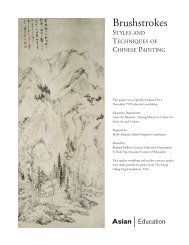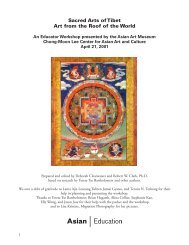Download PDF - Asian Art Museum | Education
Download PDF - Asian Art Museum | Education
Download PDF - Asian Art Museum | Education
You also want an ePaper? Increase the reach of your titles
YUMPU automatically turns print PDFs into web optimized ePapers that Google loves.
may still exist in a sense. For example, visitors to Yosemite certainly feel a sense of awe<br />
for the power and beauty of nature, and the regenerative results of a camping trip to<br />
Yosemite are not much different from what Edo travelers might have sought when visiting<br />
Fuji). Use this discussion as an introduction to Activity 1, Making a Temple Book.<br />
2) How was this painting used? Consider its size and format.<br />
Size: each screen is about 5 1/2 feet tall by 12 feet wide. What kind of room would this<br />
fit into? Imagine the space it would take up in the classroom. Remember, the screens<br />
stand on their own by arranging the panels like an accordion, so they do not extend to<br />
their full 12-feet width.<br />
Format: screens have been used for centuries in Japan not merely as room decoration<br />
but as integral parts of interior architecture. Traditional Japanese palaces and castles,<br />
where one would find screens, consisted of large, simple rooms. Free-standing screens<br />
like these might have been used to section off the room to give privacy or cover a draft.<br />
They also showed the affluence and good taste of the owner. Refer to Student Handout<br />
3, Formats of Japanese Painting.<br />
Sources:<br />
Extraordinary Persons Teacher Packet slide #4 left screen only.<br />
Kakudo, #61.<br />
<strong>Asian</strong> <strong>Art</strong> <strong>Museum</strong> <strong>Education</strong> Department
















